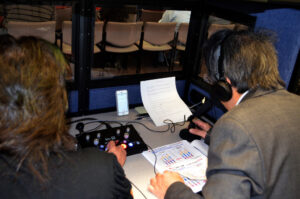
Simultaneous interpreting is a demanding profession requiring unwavering attention to detail and an ability to synthesize and analyze information. It also requires the interpreter to have the ability to adapt to ever-changing circumstances, whether they be linguistic , cultural, or geographic. Unlike many other occupations, simultaneous interpretation is not a skill one masters and then uses as needed—it is life-long education and training.
Because of the complex nature of language and culture and their interconnectedness, simultaneous interpreters must be constantly aware of new linguistic and cultural trends, and how language is used among different groups. A different style of language will be used by close friends than would be used by a speaker at a professional conference, and interpretations should capture and reflect these differences in communication.
If you are interested in booking a simultaneous interpreter for your next conference or other event, you may want to consider more than one. Especially if your event is longer than an hour or so, two interpreters will prove invaluable. It is not uncommon for simultaneous interpreters to only work 15-20 minutes at a time to prevent mental fatigue and errors in the interpretation. Very few people in today’s world focus a hundred percent on what they’re doing for a sustained period of time, but for those working in the language industry that is their daily life. If they let their attention lapse, they may miss a crucial word or phrase. Since the interpreters you chose represent you or your speakers to your non-native participants, it is essential they be focused at all times.
People often wonder about the monetary cost of hiring two interpreters for a day-long event, such as a conference. “Surely one interpreter will be enough,” they think. Simultaneous interpreting requires an unusually high level of focus at all times, and unless very frequent breaks are already scheduled as part of the event, it is likely doing your non-English speaking participants a great disservice. To think of it another way, imagine if you were required to give an eight-hour speech with a break perhaps every two hours for fifteen minutes. You would be mentally and physically exhausted, even with a detailed outline to work from.
Since the average speech is no longer than approximately 15-20 minutes, this is a good rule of thumb to keep in mind when considering how many interpreters you need for your event. By having two interpreters, they can each switch off interpreting and taking breaks as necessary. Even when resting from actively interpreting, however, they are still monitoring the original speaker and the interpretation by their colleague and are mentally taking notes (sometimes on paper as well) to insure they are ready to pick back up when it’s their turn.
Have you ever used interpreters at an event with non-native speakers? How was the experience and what, if anything, would you do differently? If you used more than one interpreter, did you find it enriched the experience for your non-native participants? Please feel free to share your experiences in the comments.
____________________________________________________________________
You may also be interested in the following:
Ebook: Top Ten Tips for Interpreters and Translators
Article: Five Things to Remember During Simultaneous Interpretation
Article: Simultaneous Interpretation and the Brain – Which parts of the brain are responsible for the ability to do simultaneous interpretation?
_____________________________________________________________________






